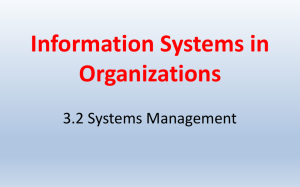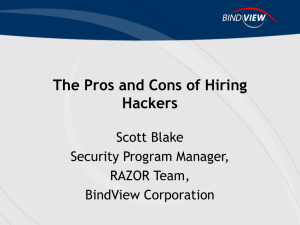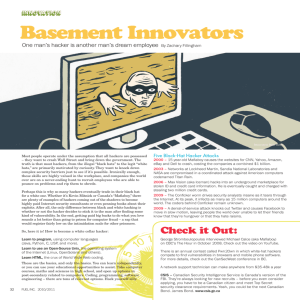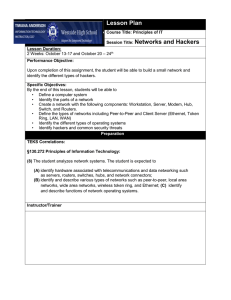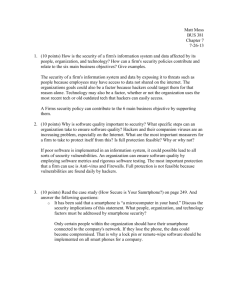Lesson Plan
advertisement
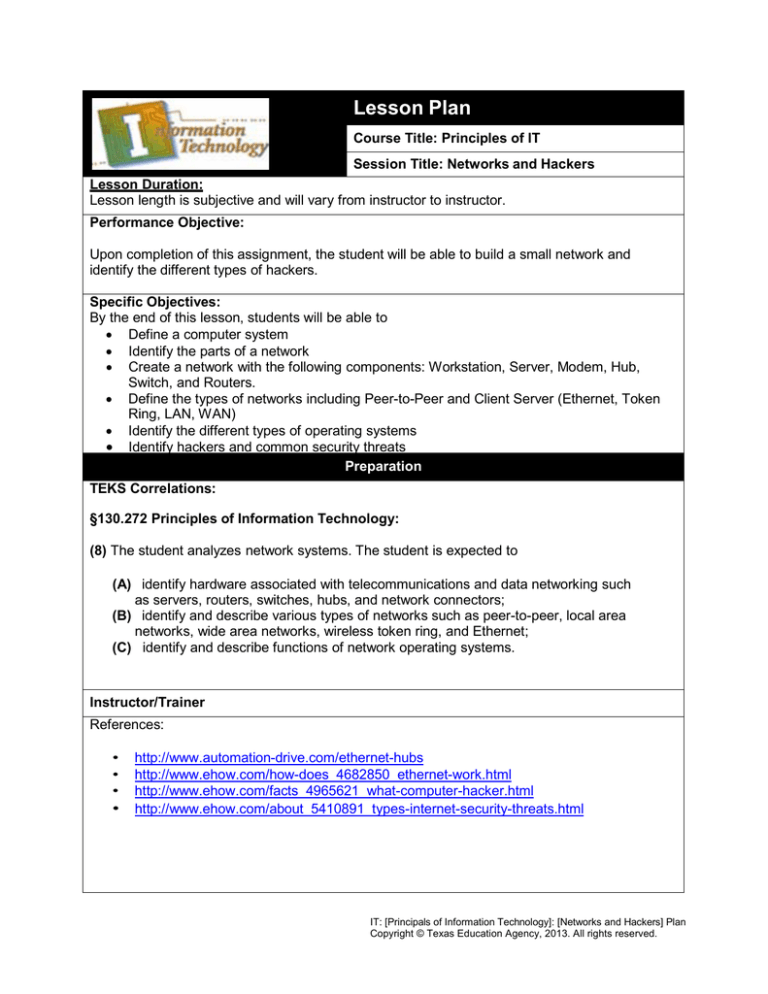
Lesson Plan Course Title: Principles of IT Session Title: Networks and Hackers Lesson Duration: Lesson length is subjective and will vary from instructor to instructor. Performance Objective: Upon completion of this assignment, the student will be able to build a small network and identify the different types of hackers. Specific Objectives: By the end of this lesson, students will be able to • Define a computer system • Identify the parts of a network • Create a network with the following components: Workstation, Server, Modem, Hub, Switch, and Routers. • Define the types of networks including Peer-to-Peer and Client Server (Ethernet, Token Ring, LAN, WAN) • Identify the different types of operating systems • Identify hackers and common security threats Preparation TEKS Correlations: §130.272 Principles of Information Technology: (8) The student analyzes network systems. The student is expected to (A) identify hardware associated with telecommunications and data networking such as servers, routers, switches, hubs, and network connectors; (B) identify and describe various types of networks such as peer-to-peer, local area networks, wide area networks, wireless token ring, and Ethernet; (C) identify and describe functions of network operating systems. Instructor/Trainer References: • • • • http://www.automation-drive.com/ethernet-hubs http://www.ehow.com/how-does_4682850_ethernet-work.html http://www.ehow.com/facts_4965621_what-computer-hacker.html http://www.ehow.com/about_5410891_types-internet-security-threats.html IT: [Principals of Information Technology]: [Networks and Hackers] Plan Copyright © Texas Education Agency, 2013. All rights reserved. Instructional Aids: • HANDOUT: Teen Hacker Article • Networks and Hackers Presentation • HANDOUT: Networks and Hackers Notes for the Presentation • HANDOUT: Lab Assignment • HANDOUT: National Treasure Extension Assignment Materials Needed: • Instructional aids • Paper for students to draw on • Color pencils, markers, and/or crayons to draw with • Flash cards for students to create review materials • National Treasure movie – only needed for extension assignment! Equipment Needed: • Projector for teacher computer Learner • This is an introduction on networks and hackers for students. No previous knowledge is needed. Introduction MI Introduction (LSI Quadrant I): SAY, “How many of you have ever logged onto a computer at school, the library, or a home office with more than one computer?” ASK, “Have you ever wondered how it all works?” Outline MI Outline (LSI Quadrant II): Teachers can use the Networks and Hackers Presentation and Handout and Lab. Instructor Notes: I. Hand out the Teen Hacker Article Handout to the students to read. I. II. Hand out the Networks and Hackers Notes Handout or advise students to take notes during the presentation. II. Hand out this article for the students to read for homework ahead of this lesson. Hand out copies of the Network and Hacker Notes to each student, or you can advise each student to get ready to take notes. IT: [Principals of Information Technology]: [Networks and Hackers] Plan Copyright © Texas Education Agency, 2013. All rights reserved. III. Show the presentation, which covers the following concepts: a. Computer system b. Parts of a network I. Workstation ii. Server Iii. Modem iv. Hub V. Switch vi. Router C. Types of networks I. Peer-to-peer ii. Client server 1. Ethernet 2. Token ring 3. Lan 4. Wan d. Operating systems e. Hackers F. Security threats III. Students should be taking notes as you are showing the Networks and Hackers Presentation. IV. Hand out the Lab Assignment to students. They will create diagrams of the networks based on seniors listed. IV. Students should draw out 3 different types of networks listed on the Lab Assignment. Have them create a legend for the different parts of the network they are trying to draw – like a box with the word Router for a router. V. Work through the SOHO portion of the lab together – the key listed is one of many solutions. VI. Work through the SOHO setup as a class so that students understand what you are looking for. VII. Student groups need to finish up the Lab Assignment. V. Divide students into groups of two or three. Have them complete the Lab Assignment for the small office and world wide company. IT: [Principals of Information Technology]: [Networks and Hackers] Plan Copyright © Texas Education Agency, 2013. All rights reserved. VIII. Review for Networks and Hackers Quiz VI. After completion of the lab, have students create flash cards of the important terms to study for the quiz. Application MI Guided Practice (LSI Quadrant III): Do the SOHO portion of the lab as a class. MI Independent Practice (LSI Quadrant III): Hand out the Lab Assignment. Divide students into groups of two or three. Have each group work together on the following… SAY, “Students, now that you see how we have set up a SOHO, see if you and a partner can come up with one possible solution to the rest of the problems on the Lab Assignment.” Summary MI Review (LSI Quadrants I and IV): SAY, “Now that we have a good understanding about Networks, we need to study for our quiz. In your groups, each of you needs to create your own set of flash cards to study. Work together as a group to make sure that you do not miss any important concepts or terms. I will need to review these to make sure that I feel you are not missing anything. I would also draw out our SOHO example so that you do not forget it later.” Evaluation MI Informal Assessment (LSI Quadrant III): IT: [Principals of Information Technology]: [Networks and Hackers] Plan Copyright © Texas Education Agency, 2013. All rights reserved. • • MI Teacher checks for understanding while going through the SOHO portion of the lab as a class. Review of student-created flash cards Formal Assessment (LSI Quadrant III, IV): • • Completion of the rest of the Lab Assignment done in groups. Networks and Hackers Quiz Extension MI Extension/Enrichment (LSI Quadrant IV): Upon completion of the Networks and Hackers Lesson, have students watch the movie National Treasure. Have students complete the HANDOUT: National Treasure Extension Assignment. IT: [Principals of Information Technology]: [Networks and Hackers] Plan Copyright © Texas Education Agency, 2013. All rights reserved. Icon MI Verbal/ Linguistic Logical/ Mathematical Visual/Spatial Musical/ Rhythmic Bodily/ Kinesthetic Intrapersonal Interpersonal Naturalist Existentialist Teaching Strategies Personal Development Strategies Lecture, discussion, journal writing, cooperative learning, word origins Reading, highlighting, outlining, teaching others, reciting information Problem solving, number games, critical thinking, classifying and organizing, Socratic questioning Mind-mapping, reflective time, graphic organizers, color-coding systems, drawings, designs, video, DVD, charts, maps Use music, compose songs or raps, use musical language or metaphors Organizing material logically, explaining things sequentially, finding patterns, developing systems, outlining, charting, graphing, analyzing information Developing graphic organizers, mindmapping, charting, graphing, organizing with color, mental imagery (drawing in the mind’s eye) Use manipulatives, hand signals, pantomime, real life situations, puzzles and board games, activities, roleplaying, action problems Reflective teaching, interviews, reflective listening, KW L charts Cooperative learning, roleplaying, group brainstorming, cross-cultural interactions Natural objects as manipulatives and as background for learning Socratic questions, real life situations, global problems/questions Creating rhythms out of words, creating rhythms with instruments, playing an instrument, putting words to existing songs Moving while learning, pacing while reciting, acting out scripts of material, designing games, moving fingers under words while reading Reflecting on personal meaning of information, studying in quiet settings, imagining experiments, visualizing information, journaling Studying in a group, discussing information, using flash cards with other, teaching others Connecting with nature, forming study groups with like-minded people Considering personal relationship to larger context IT: [Principals of Information Technology]: [Networks and Hackers] Plan Copyright © Texas Education Agency, 2013. All rights reserved. Student Name: Date: Networks and Hackers Notes: Computer System • A basic computer system is made up of two parts: (physical equipment that you can touch), and (programs installed on the computer). Computer Networks • Computer Networks allow users to over distances. They allow , , and , making them a necessary tool for offices, schools, and homes all over the world. A computer network consists of several , each of which is important to making the network function correctly as a whole. Network: Parts of a Network Workstations • These are known as home or school would be called a workstation in a network. . The computer you use at Servers • Servers can look like desktop computers; however, most do not look like your “normal” computer. Servers do not really need and , . What they really need is hard drives. In most schools, when you save your work, you are saving to a server. By doing this, you can access your schoolwork from any computer that is on your school network. Modems • A modem is a device that enables computers to they receive from a network or send data in the proper form along a network. Hubs • A hub is sort of like a car radio. Every computer that has that section of network (like a radio station) can hear that is being transmitted. All the computers that are connected to that hub receive all the information that goes through it. Usually, if you have a hub, you also have a . IT: [Principals of Information Technology]: [Networks and Hackers] Plan Copyright © Texas Education Agency, 2013. All rights reserved. Student Name: Date: Switches • A switch is more complex than a hub and works a lot like a two-way radio. In a room full of people, only the person holding the other radio can hear what is being said. It keeps track of which computers are where, and when something comes in, it sends it only to that --not every computer on that section of the network. It is more secure than a hub and faster than a hub, but not as powerful as a router. Routers • Routers work a lot like a . Each computer is given its own unique number by the router. When information comes into the router, it is sent along to the correct number, or in this case, • . There are more options built into routers than there are available to switches. A router can have the equivalent phone options of and . This is beyond a switch’s capabilities. Peer- to- Peer Network • This is a type of network where the computers in the network share among each other. • Every computer on this network is ; all the computers run the same , and for sharing. , • , and other are shared by the machine they are plugged into, otherwise known as managed by. Advantages • It is to set up a peer-to-peer network initially. • You may already own the network setup. • This type of network does not require the installation of dedicated needed to get a peer-to-peer or expensive security software. IT: [Principals of Information Technology]: [Networks and Hackers] Plan Copyright © Texas Education Agency, 2013. All rights reserved. Student Name: Date: Disadvantages • If you have a peer-to-peer network, you need to be aware that , such as printers, place a special demand on the • in the network. Also, due to the nature of this type of network, all of the computers on the network provide access to all of the machine’s resources. The down side of this is that you can unintentionally expose to all the other users on the network. • There is also no or from hackers, viruses, etc. Peer-to-Peer Operating Systems • In the peer-to-peer network operating system, each workstation has an operating system that tells them how to and with each other. • The two software packages that allow this type of network are called (for MACs) and (for PCs) Client Server Networks Ethernet • Ethernet is a type of basis of most LANs. • It also serves as one of the main methods for connecting a computer or network to an between computers that forms the . • The origin of Ethernet was the idea of connecting several computers together in a network via ; since that time, it has evolved into a much more sophisticated system that uses specialized that connect to a central hub or router to network several computers together. IT: [Principals of Information Technology]: [Networks and Hackers] Plan Copyright © Texas Education Agency, 2013. All rights reserved. Student Name: Date: LAN • LAN stands for . • A local area network is a group of computers that are together that share internet access, file access, applications, storage, and allow computers to share printers and scanners. LAN Issues • For a LAN to work properly, a must be installed on the primary computer that is connected to the internet. Each computer connected to the LAN must have an • installed. The other issue with a LAN is that they are usually confined in a . WAN • WAN stands for . • A WAN is a collection of regular that are all interconnected to form one . Oftentimes, schools and even large companies will operate a WAN on premises. Advantages • : School networks can be created for students to access files throughout the school district. : Networks speed up the file sharing and • saving process. Disadvantages : WANs save money over • time, but they are expensive to set up at first. • : WANs require maintenance of the network, which costs both money and time. Token Rings • Token rings work by sending data from one machine to the next around a until it ends up back where it started. IT: [Principals of Information Technology]: [Networks and Hackers] Plan Copyright © Texas Education Agency, 2013. All rights reserved. Student Name: Date: • It also uses a special token passing protocol, which means that a machine can only use the network when it has control of the . This ensures that there are no collisions because only one machine can use the network at any given time. Token Ring Issues • In order for token rings to work, • all computers must check for or tokens. • all connected computers must “ ” a new leader to a new token. Client/Server Operating Systems • Client/Server setup allows the network to centralize functions and applications in or • file server. File servers become the “ ” of this system and provide to files and resources, as well as providing security. • Workstations have on the file servers. to the resources to files Client/Server Operating Systems • There are many different kinds of software out there for this type of network. The most popular ones are • • • • Advantages • This type of network makes it easy to install and . • The server can be have both MACs and PCs on the network. • Client/Server operating systems remotely, and you can IT: [Principals of Information Technology]: [Networks and Hackers] Plan Copyright © Texas Education Agency, 2013. All rights reserved. Student Name: Date: Disadvantages: • Client/Servers depend on their servers. When they go down, the will no longer work. • There is a hefty for a client/server network. It pays off in the long run, but it requires money to set it up. • Large networks will require to maintain a client/server network and to work out the “kinks” when problems arise. Network Threats Hackers • A computer hacker is someone who finds security system to break into another machine. • in a computer’s Hackers usually collect information on the target computer and then try to find into the computer system. Security Threats • The most common threats are : this is unwanted commercial e-mail. • : can cause your computer to slow down or • even destroy your hard drive. • : this is software that gets installed on the computer. It can cause annoying pop-ups or even steal information. • : hackers steal important information: client information, bank account numbers, etc. Hackers • Networks can take steps to protect their networks. The most common are • • • IT: [Principals of Information Technology]: [Networks and Hackers] Plan Copyright © Texas Education Agency, 2013. All rights reserved. Student Name: Date: Networks and HackersNotes: KEY Computer System • A basic computer system is made up of two parts: hardware (physical equipment that you can touch) and software (programs installed on the computer). Computer Networks • Computer networks allow users to connect over distances. They allow file sharing, hardware sharing, and instant communication, making them a necessary tool for offices, schools, and homes all over the world. A computer network consists of several components, each of which is important to making the network function correctly as a whole. Network: Parts of a Network Workstations • These are known as desktop computers. The computer you use at home or school would be called a workstation in a network. Servers • Servers can look like desktop computers; however, most do not look like your “normal” computer. Servers do not really need monitors, graphics, and sound cards. What they really need is hard drives. In most schools, when you save your work, you are saving to a server. By doing this, you can access your schoolwork from any computer that is on your school network. Modems • A modem is a device that enables computers to interpret data they receive from a network or send data in the proper form along a network. Hubs • A hub is sort of like a car radio. Every computer that has that section of network (like a radio station) can hear everything that is being transmitted. All the computers that are connected to that hub receive all the information that goes through it. Usually, if you have a hub, you also have a router. Switches • A switch is more complex than a hub and works a lot like a two-way radio. In a room full of people, only the person holding the other radio can hear what is being said. It keeps track of which computers are where, and when something comes in, it sends it only to that specific computer, not every computer on that section of the network. It is more secure than a hub and faster than a hub, but it is not as powerful as a router. Routers • Routers work a lot like a telephone system. Each computer is given its own unique number by the router. When information comes into the router, it is then sent along to the correct number, or in this case, computer. IT: [Principals of Information Technology]: [Networks and Hackers] Plan Copyright © Texas Education Agency, 2013. All rights reserved. Student Name: Date: • There are more options built into routers than there are available to switches. A router can have the equivalent phone options of call screening and caller ID. This is beyond a switch’s capabilities. Peer-to-Peer Network • This is a type of network where the computers in the network share resources among each other. • Every computer on this network is equal; all the computers run the same networking software and file systems for sharing. • Printers, scanners, and other external devices are shared by the machine they are plugged into, otherwise known as managed by. Advantages • It is less expensive to set up a peer-to-peer network initially. • You may already own the software needed to get a peer-to-peer network setup. • This type of network does not require the installation of dedicated server hardware or expensive security software. Disadvantages • If you have a peer-to-peer network, you need to be aware that shared resources, such as printers, place a special demand on the computers in the network. • Also, due to the nature of this type of network, all of the computers on the network provide access to all of the machine’s resources. The down side of this is that you can unintentionally expose private files to all the other users on the network. • There is also no data security or protection from hackers, viruses, etc. Peer-to-Peer Operating Systems • In the peer-to-peer network operating system, each workstation has an operating system that tells them how to store and share resources with each other. • The two software packages that allow this type of network are called Appleshare (for MACs) and Windows for Workgroups (for PCs) Client Server Networks Ethernet • Ethernet is a type of connection between computers that forms the basis of most LANs. • It also serves as one of the main methods for connecting a computer or network to an Internet hub. • The origin of Ethernet was the idea of connecting several computers together in a network via coaxial cables; since that time, it has evolved into a much more IT: [Principals of Information Technology]: [Networks and Hackers] Plan Copyright © Texas Education Agency, 2013. All rights reserved. Student Name: Date: sophisticated system that uses specialized Ethernet cables that connect to a central hub or router in order to network several computers together. LAN • LAN stands for Local Area Network. • A local area network is a group of computers that are linked together that share internet access, file access, applications, storage, and allow connected computers to share printers and scanners. LAN Issues • For a LAN to work properly, a router must be installed on the primary computer that is connected to the internet. Each computer connected to the LAN must have an Ethernet card installed. • The other issue with a LAN is that they are usually confined in a single building. WAN • WAN stands for Wide Area Networks. • A WAN is a collection of regular local area networks that are all interconnected to form one giant network. Oftentimes, schools and even large companies will operate a WAN on premises. Advantages • Flexible Access: School networks can be created for students to access files throughout the school district. • Speed: Networks speed up the file sharing and saving process. Disadvantages • Expensive to Install: WANs save money over time, but they are expensive to set up at first. • Time: WANs require maintenance of the network, which costs both money and time. Token Rings • Token rings work by sending data from one machine to the next and so on around a ring until it ends up back where it started. • It also uses a special token passing protocol, which means that a machine can only use the network when it has control of the token; this ensures that there are no collisions because only one machine can use the network at any given time. Token Ring Issues • In order for token rings to work, • All computers must check for lost or duplicate tokens. • All connected computers must “vote” a new leader to create a new token. IT: [Principals of Information Technology]: [Networks and Hackers] Plan Copyright © Texas Education Agency, 2013. All rights reserved. Student Name: Date: Client/Server Operating Systems • Client/Server setup allows the network to centralize functions and applications in one or more file server. • File servers become the “heart” of this system and provide access to files and resources, as well as providing security. • Workstations have access to the resources to files on the file servers. Client/Server Operating Systems • There are many different kinds of software out there for this type of network. The most popular ones are • Macintosh OSX • Microsoft Windows Server • Novell • UNIX Advantages • This type of network makes it easy to install new technology and new elements. • The server can be accessed remotely, and you can have both MACs and PCs on the network. • Client/Server Operating Systems Disadvantages • Client/Servers depend on their servers. When they go down, the network will no longer work. • There is a hefty investment for a client/server network. It pays off in the long run, but it requires money to set it up. • Large networks will require dedicated staff to maintain a client/server network and to work out the “kinks” when problems arise. Network Threats Hackers • A computer hacker is someone who finds access in a computer’s security system to break into another machine. • Hackers usually collect information on the target computer and then try to find access into the computer system. Security Threats • The most common threats are IT: [Principals of Information Technology]: [Networks and Hackers] Plan Copyright © Texas Education Agency, 2013. All rights reserved. Student Name: Date: • Spam: this is unwanted commercial e-mail. • Viruses: can cause your computer to slow down or even destroy your hard drive. • Adware/Malware: this is software that gets installed on the computer. It can cause annoying pop-ups or even steal information. • Information Threats: Hackers steal important information: client information, back account numbers, etc. Hackers • Networks can take steps to protect their networks. The most common are • Installing a firewall • Advising caution on the net • Making sure the network is password protected, especially if using a wireless network. . IT: [Principals of Information Technology]: [Networks and Hackers] Plan Copyright © Texas Education Agency, 2013. All rights reserved. Student Name: Date: Networks and Hackers Lab Assignment: Case Studies: 1. Together, we are going to draw out a SOHO (Small Office, Home Office) Network. We need to have the following parts in our design: o Desktop computer o Printer o Scanner o Wireless router o A laptop 2. We have a school computer lab that wants a peer-to-peer network created for this lab. They have the following items that need to be in the design: o 15 desktop computers o 5 scanners o 1 color printer o 1 black and white printer 3. Now, come up with your own scenario and solution. See who can be the most creative! IT: [Principals of Information Technology]: [Networks and Hackers] Plan Copyright © Texas Education Agency, 2013. All rights reserved. Student Name: Date: Networks and Hackers Lab Assignment: KEY Case Studies: 1. Together, we are going to draw out a SOHO (Small Office, Home Office) Network. We need to have the following parts in our design: o Desktop computer o Printer o Scanner o Wireless router o A laptop Listed below are two versions of what this key can look like. This is just a sample—students can draw this out so many ways. Wireless Router Wireless Router Desktop Computer Laptop Printer Scanner IT: [Principals of Information Technology]: [Networks and Hackers] Plan Copyright © Texas Education Agency, 2013. All rights reserved. Student Name: Date: 2. We have a School Computer Lab that wants a peer-to-peer network created for this lab. They have the following items that need to be in the design: o 15 desktop computers o 5 scanners o 1 color printer o 1 black and white printer IT: [Principals of Information Technology]: [Networks and Hackers] Plan Copyright © Texas Education Agency, 2013. All rights reserved. Student Name: Date: Networks and Hackers Quiz True/False Indicate whether the statement is true or false. 1 All computer networks are fairly simple, containing only a few components. A True B False 2 A hub is like a car radio. Every computer on that section of the network can hear everything that is being transmitted. A True B False 3 A switch is more powerful than a router. A True B False 4 A WAN is a collection of LANs forming one giant network. A True B False 5 WANs are a cheap investment. A True B False 6 There are many advantages to having a client/server operating system, one of which is that you can have both Macs and PCs on the same network. A True B False Multiple Choice Identify the choice that best completes the statement or answers the question. 7 All computer systems are made up of two parts: A Hardware and Firewalls C Servers and Routers B Software and Computers D Hardware and Software 8 A workstation is a A server B desktop computer C Router D None of the Above IT: [Principals of Information Technology]: [Networks and Hackers] Plan Copyright © Texas Education Agency, 2013. All rights reserved. Student Name: Date: 9 A Modem A is used only for the Internet B is installed on every computer ever made C interprets data from a network D is all you need to make a network. 10 In this type of network, all the connected computers are equal. A Ethernet C Peer-To-Peer B Client/Server D Server/Client 11 The Ethernet came about originally by A telephone cables B coaxial cables C wires D none of the above Multiple Response Identify one or more choices that best complete the statement or answer the question. 12 In a peer-to-peer network, the most common types of operating software used are A AppleShare C UNIX B Windows for Workgroups D Novell 13 LANs allow for the following resources to be shared: A Files C Printers B Internet D Scanners 14 The most common security threats are: A Spam B Firewalls C Viruses D Time Bombs Case 15 Draw out a SOHO set that contains the following parts: Desktop Computer Printer Scanner Wireless Router 2 Laptops Photo Printer IT: [Principals of Information Technology]: [Networks and Hackers] Plan Copyright © Texas Education Agency, 2013. All rights reserved. Student Name: Date: Networks and Hackers Quiz Answer Section TRUE/FALSE 1 ANS: F That may be true of the SOHO (Small Office, Home Office) networks, but most global companies have WANs with hundreds of networks inside them. They can have thousands of components. 2 ANS: T 3 ANS: F A router is more powerful than a switch. 4 ANS: T 5 ANS: F Actually WANs are a major investment, but they pay off over time. 6 ANS: T MULTIPLE CHOICE 7 ANS: D It is made up of both hardware you can touch and software installed on the computer. 8 ANS: C 9 ANS: C A modem is a device that enables computers to interpret data they receive from a network. 10 ANS: C All of the computers will share resources, and all the computers are equal. In both Ethernet and client/server networks, there is a server who is considered “the boss”. 11 ANS: B MULTIPLE RESPONSE 12 ANS: A, B UNIX and Novell are for client/server networks. 13 ANS: A, B, C, D All are allowed to be shared on a LAN 14 ANS: A, C Spam, viruses, adware, and information theft are the most common security threats. CASE 15 ANS: The student should have drawn this out just like the independent practice done as a class. The only parts added are an extra laptop and photo printer. IT: [Principals of Information Technology]: [Networks and Hackers] Plan Copyright © Texas Education Agency, 2013. All rights reserved. National Treasure Extension Assignment Write a one-page essay containing one or two paragraphs discussing the following: o Discuss the security measures used today to protect the Declaration of Independence and their effectiveness. o Discuss the security measures used in the 1700s to protect the location of the map and their effectiveness. o Include in both discussions (where applicable) the use of the following physical security access control measures: Lock Conduit Card key Video equipment Security card Biometric Passwords Symmetric encryption o The essay must contain at least four examples of the above control measures of physical security access with supporting sentences. The essay needs to be at least one page, double-spaced, with 12-point Times New Roman font. All margins need to be one inch. The title and header with your name needs to be 12-point Times New Roman font as well. The essay can contain one or two paragraphs. IT: [Principals of Information Technology]: [Networks and Hackers] Plan Copyright © Texas Education Agency, 2013. All rights reserved. IT: [Principals of Information Technology]: [Networks and Hackers] Plan Copyright © Texas Education Agency, 2013. All rights reserved. IT: [Principals of Information Technology]: [Networks and Hackers] Plan Copyright © Texas Education Agency, 2013. All rights reserved.
